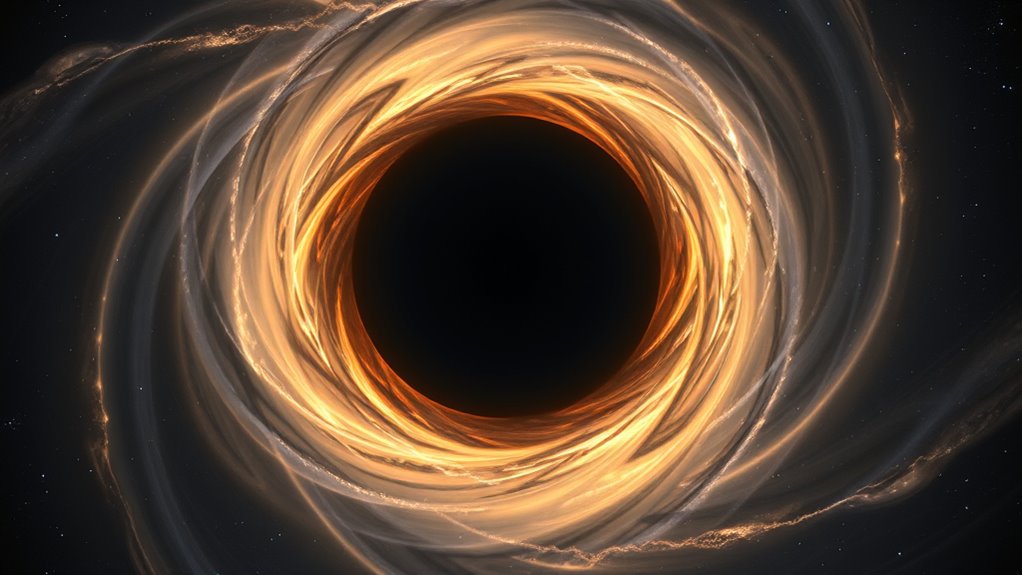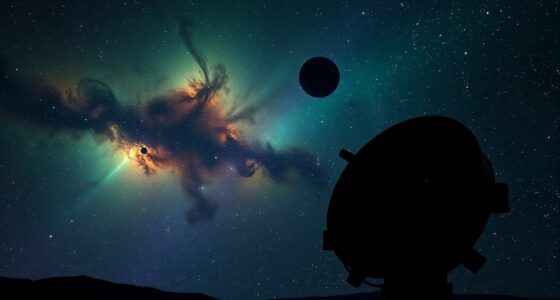Gravitational waves, often called cosmic bells, have been directly detected by LIGO, confirming key predictions about black holes and spacetime. When massive objects like black holes merge, they produce ripples that travel through the universe at light speed. This detection supports Hawking’s black hole theorem, showing that black hole properties follow certain laws. If you keep exploring, you’ll discover how this breakthrough opens new windows into understanding our universe.
Key Takeaways
- LIGO’s detection of gravitational waves confirms they behave like cosmic bells, ringing from black hole mergers.
- Data shows black hole surface area increases during mergers, supporting Hawking’s black hole theorem.
- Gravitational wave signals reveal black hole properties, validating predictions about their mass and spin.
- The observations demonstrate that black holes obey fundamental physics laws, including the increasing surface area.
- This confirmation enhances understanding of black hole behavior and confirms Einstein’s general relativity.

Gravitational waves are ripples in spacetime caused by massive accelerating objects, such as merging black holes or neutron stars. When these cosmic giants collide or spiral closer, they produce disturbances that propagate outward at the speed of light. These waves carry information about their violent origins, allowing you to peek into the most extreme events in the universe. Detecting these waves isn’t easy; it requires incredibly sensitive instruments that can measure distortions smaller than a proton’s diameter. That’s where the Laser Interferometer Gravitational-Wave Observatory (LIGO) comes into play, functioning like a giant cosmic ear tuned to these faint signals. When LIGO detects a gravitational wave, it confirms that spacetime itself is stretching and squeezing in response to these cataclysmic events.
LIGO’s observations have revolutionized your understanding of black holes and neutron stars. By analyzing the waveforms, you can determine the properties of the merging objects, including their masses and spins. This data helps test predictions from Einstein’s general relativity, especially during the most energetic phases of these collisions. When LIGO announced its first detection in 2015, it was a landmark moment—proof that gravitational waves exist and that you can observe the universe in a completely new way. Since then, multiple detections have confirmed that these waves are common in the cosmos, opening up a new era in astronomy.
One of the most fascinating aspects of these discoveries is their relation to black hole physics, particularly Hawking’s black hole theorem. Stephen Hawking predicted that black holes should have specific properties, like a well-defined surface area that can only increase. LIGO’s data has provided strong evidence supporting this idea. When black holes merge, the resulting black hole’s mass and spin follow relationships that align with Hawking’s theorem, confirming that the laws governing black holes are consistent with theoretical predictions. This validation helps you understand that black holes aren’t just mysterious objects; they obey the fundamental laws of physics in predictable ways. Additionally, the detection of gravitational waves has helped confirm some aspects of theoretical physics, deepening our understanding of the universe’s fundamental structure.
Frequently Asked Questions
How Do Gravitational Waves Travel Through Space?
You might wonder how gravitational waves travel through space. They move at the speed of light, rippling through the fabric of spacetime caused by massive cosmic events like black hole mergers. As they propagate, they stretch and squeeze space, but their effect is tiny by the time they reach us. These waves carry information about their origins, allowing you to observe phenomena that are otherwise invisible with traditional telescopes.
Can Gravitational Waves Be Detected From Other Cosmic Events?
Yes, you can detect gravitational waves from other cosmic events, like ripples spreading across a pond after a stone drops. When massive objects like merging black holes or neutron stars collide, they send out these waves, traveling vast distances at the speed of light. Instruments like LIGO and Virgo act as cosmic ears, listening for these faint signals that reveal dramatic, unseen astrophysical phenomena happening millions or billions of light-years away.
What Instruments Are Used to Measure Gravitational Waves?
You use advanced detectors like LIGO and Virgo to measure gravitational waves. These instruments consist of massive laser interferometers that detect tiny disturbances caused by passing waves. When a gravitational wave stretches or compresses space, the laser beams’ lengths change minutely, creating measurable interference patterns. By analyzing these signals, you can confirm the presence of cosmic events like black hole mergers and neutron star collisions.
How Do Gravitational Waves Affect Earth?
Gravitational waves are like ripples on a pond, but on a cosmic scale, and they cause tiny vibrations in Earth’s fabric. When these waves pass through, you might notice minuscule shifts in space, though they’re incredibly faint. These vibrations can slightly alter distances between objects, but modern detectors, like LIGO, measure these effects with extraordinary precision, helping us understand the universe’s most powerful events without causing noticeable changes on your daily life.
Are Gravitational Waves Visible to the Naked Eye?
No, you can’t see gravitational waves with your naked eye. These waves are ripples in spacetime caused by massive cosmic events, and they are incredibly faint by the time they reach Earth. To detect them, scientists use highly sensitive instruments like LIGO, which can measure tiny disturbances far smaller than an atomic nucleus. So, while they tell us a lot about the universe, gravitational waves remain invisible to the human eye.
Conclusion
You can now see how gravitational waves act like cosmic bells, confirming Hawking’s black hole theorem. This discovery proves that black holes have predictable properties, matching Einstein’s predictions more closely than ever. It’s a huge step forward in understanding the universe’s most mysterious objects. As scientists continue to explore, you can be confident that our knowledge of black holes is growing, revealing the intricate dance of gravity and spacetime in ways we once only imagined.










